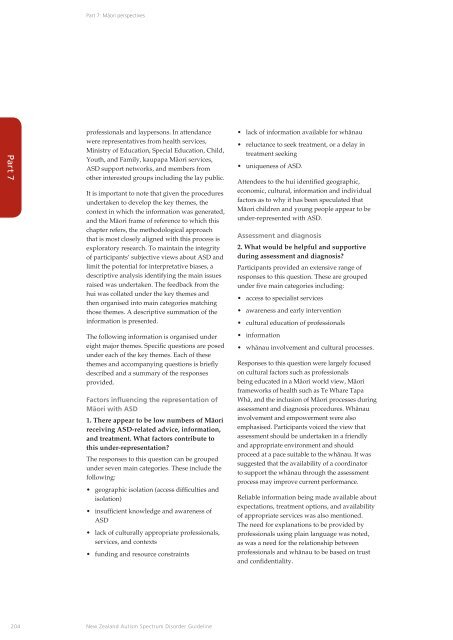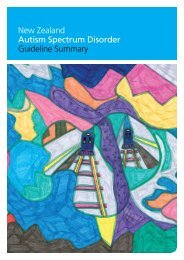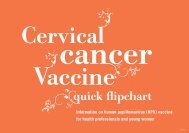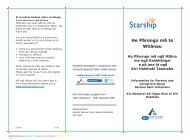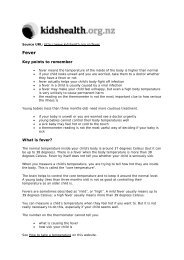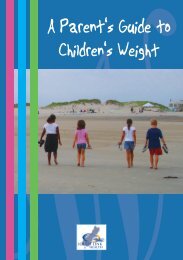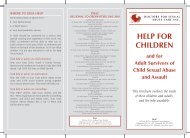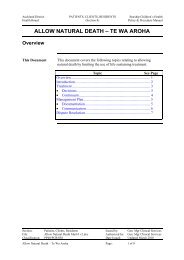New Zealand Autism Spectrum Disorder Guideline - Ministry of Health
New Zealand Autism Spectrum Disorder Guideline - Ministry of Health
New Zealand Autism Spectrum Disorder Guideline - Ministry of Health
Create successful ePaper yourself
Turn your PDF publications into a flip-book with our unique Google optimized e-Paper software.
Part 7: Mäori perspectives<br />
Part 7<br />
pr<strong>of</strong>essionals and laypersons. In attendance<br />
were representatives from health services,<br />
<strong>Ministry</strong> <strong>of</strong> Education, Special Education, Child,<br />
Youth, and Family, kaupapa Mäori services,<br />
ASD support networks, and members from<br />
other interested groups including the lay public.<br />
It is important to note that given the procedures<br />
undertaken to develop the key themes, the<br />
context in which the information was generated,<br />
and the Mäori frame <strong>of</strong> reference to which this<br />
chapter refers, the methodological approach<br />
that is most closely aligned with this process is<br />
exploratory research. To maintain the integrity<br />
<strong>of</strong> participants’ subjective views about ASD and<br />
limit the potential for interpretative biases, a<br />
descriptive analysis identifying the main issues<br />
raised was undertaken. The feedback from the<br />
hui was collated under the key themes and<br />
then organised into main categories matching<br />
those themes. A descriptive summation <strong>of</strong> the<br />
information is presented.<br />
The following information is organised under<br />
eight major themes. Specific questions are posed<br />
under each <strong>of</strong> the key themes. Each <strong>of</strong> these<br />
themes and accompanying questions is briefly<br />
described and a summary <strong>of</strong> the responses<br />
provided.<br />
Factors influencing the representation <strong>of</strong><br />
Mäori with ASD<br />
1. There appear to be low numbers <strong>of</strong> Mäori<br />
receiving ASD-related advice, information,<br />
and treatment. What factors contribute to<br />
this under-representation?<br />
The responses to this question can be grouped<br />
under seven main categories. These include the<br />
following:<br />
• geographic isolation (access difficulties and<br />
isolation)<br />
• insufficient knowledge and awareness <strong>of</strong><br />
ASD<br />
• lack <strong>of</strong> culturally appropriate pr<strong>of</strong>essionals,<br />
services, and contexts<br />
• funding and resource constraints<br />
• lack <strong>of</strong> information available for whänau<br />
• reluctance to seek treatment, or a delay in<br />
treatment seeking<br />
• uniqueness <strong>of</strong> ASD.<br />
Attendees to the hui identified geographic,<br />
economic, cultural, information and individual<br />
factors as to why it has been speculated that<br />
Mäori children and young people appear to be<br />
under-represented with ASD.<br />
Assessment and diagnosis<br />
2. What would be helpful and supportive<br />
during assessment and diagnosis?<br />
Participants provided an extensive range <strong>of</strong><br />
responses to this question. These are grouped<br />
under five main categories including:<br />
• access to specialist services<br />
• awareness and early intervention<br />
• cultural education <strong>of</strong> pr<strong>of</strong>essionals<br />
• information<br />
• whänau involvement and cultural processes.<br />
Responses to this question were largely focused<br />
on cultural factors such as pr<strong>of</strong>essionals<br />
being educated in a Mäori world view, Mäori<br />
frameworks <strong>of</strong> health such as Te Whare Tapa<br />
Whä, and the inclusion <strong>of</strong> Mäori processes during<br />
assessment and diagnosis procedures. Whänau<br />
involvement and empowerment were also<br />
emphasised. Participants voiced the view that<br />
assessment should be undertaken in a friendly<br />
and appropriate environment and should<br />
proceed at a pace suitable to the whänau. It was<br />
suggested that the availability <strong>of</strong> a coordinator<br />
to support the whänau through the assessment<br />
process may improve current performance.<br />
Reliable information being made available about<br />
expectations, treatment options, and availability<br />
<strong>of</strong> appropriate services was also mentioned.<br />
The need for explanations to be provided by<br />
pr<strong>of</strong>essionals using plain language was noted,<br />
as was a need for the relationship between<br />
pr<strong>of</strong>essionals and whänau to be based on trust<br />
and confidentiality.<br />
204<br />
<strong>New</strong> <strong>Zealand</strong> <strong>Autism</strong> <strong>Spectrum</strong> <strong>Disorder</strong> <strong>Guideline</strong>


